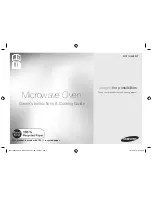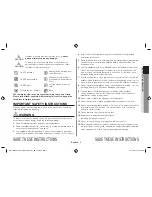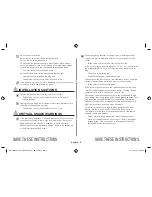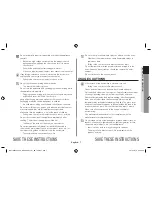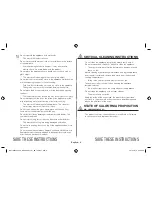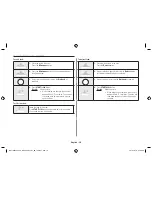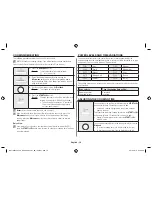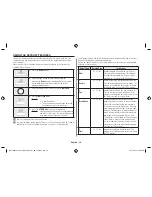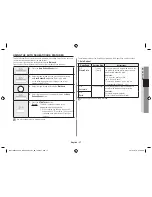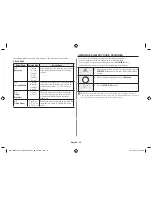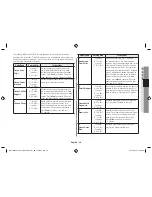
English - 4
English - 5
Save theSe inStructionS
Save theSe inStructionS
Save theSe inStructionS
CAUTION
cauTion
1.
Over The Range Model Only
- Clean Ventilating Hoods Frequently - Grease should not be allowed to
accumulate on the hood or the filter.
- When flaming foods under the hood, turn the fan on.
- Use care when cleaning the vent-hood filter. Corrosive cleaning agents,
such as lye-based oven cleaners, may damage the filter.
2.
Push Button Type Model Only
- To avoid possible exposure to excessive micro oven energy : Do not
attempt to open the door by pulling any part of the door by hand.
Open the door by pushing the button located on the front-right-bottom
side of the microwave only.
GroundinG insTrucTions
This appliance must be grounded. In the event of an electrical short circuit,
grounding reduces the risk of electric shock by providing an escape wire for
the electrical current. This appliance is equipped with a cord that includes
a grounding wire and a grounding plug. The plug must be plugged into an
outlet that is properly installed and grounded.
WARNING
WarninG
Improper use of the grounding plug can result in a risk of electric shock.
-
Plug into a grounded 3 prong outlet. Do not remove the third (grounding)
prong. Do not use an adaptor or otherwise defeat the grounding plug.
-
Consult a qualified electrician or service person if you do not understand
the grounding instructions or if you are not sure if the appliance is
properly grounded.
-
We do not recommend using an extension cord with this appliance.
If the power-supply cord is too short, have a qualified electrician
or serviceman install an outlet near the appliance. However, if it is
necessary to use an extension cord, read and follow the “Use of
Extension Cords” section below.
usE of EXTEnsion cords
A short power-supply cord is provided to reduce the risk of your becoming
entangled in or tripping over a longer cord. Longer cord sets or extension
cords are available and you can use them if you exercise care. If you use a
long cord or extension cord:
1.
The marked electrical rating of the cord set or extension cord should be
at least as great as the electrical rating of the appliance.
2.
The extension cord must be a grounding-type 3-wire cord and it must
be plugged into a 3-slot
outlet.
3.
The longer cord should be arranged so that it will not drape over the
counter top or tabletop where it can be pulled on by children or tripped
over accidentally. If you use an extension cord, the interior light may
flicker and the speed of the blower may vary when the microwave oven
is on. Cooking times may be longer too.
WARNING
criTicaL insTaLLaTion WarninGs
The installation of this appliance must be performed by a qualified
technician or service company.
-
Failing to have a qualified technician install the oven may result
in electric shock, fire, an explosion, problems with the product,
or injury.
Unpack the oven, remove all packaging material and examine the
oven for any damage such as dents on the interior or exterior of
the oven, broken door latches, cracks in the door, or a door that
is not lined up correctly. If there is any damage, do not operate
the oven and notify your dealer immediately.
Make sure to install your oven in a location with adequate space.
Remove all foreign substances such as dust or water from the
power plug terminals and contact points using a dry cloth on a
regular basis.
- Unplug the power plug and clean it with a dry cloth.
- Failing to do so may result in electric shock or fire.
17.
To reduce the risk of fire in the oven cavity:
a.
Do not overcook food. Carefully attend the appliance when paper,
plastic, or other combustible materials are placed inside the oven to
facilitate cooking.
b.
Remove wire twist-ties from paper or plastic bags before placing the
bags in the oven.
c.
If materials inside the oven ignite, keep the oven door
closed, turn the
oven off, and disconnect the power cord, or shut off the power at the
fuse or circuit breaker panel. If the door is opened, the fire may spread.
d.
Do not use the cavity for storage. Do not leave paper products,
cooking utensils, or food in the cavity when not in use.
18.
Liquids, such as water, milk, coffee, or tea can be overheated beyond the
boiling point without appearing to be boiling. Visible bubbling or boiling when
the container is removed from the microwave oven is not always present.
THIS COULD RESULT IN VERY HOT LIQUIDS SUDDENLY BOILING
OVER WHEN THE CONTAINER IS DISTURBED OR A SPOON OR OTHER
UTENSIL IS INSERTED INTO THE LIQUID. To reduce the risk of injury:
a.
Do not overheat liquid.
b.
Stir liquid both before and halfway through heating it.
c.
Do not use straight-sided containers with narrow necks.
d.
After heating, allow the container to stand in the microwave oven for
a short time before removing the container.
e.
Use extreme care when inserting a spoon or other utensil into the
container.
19.
Oversized foods or oversized metal utensils should not inserted into
microwave / toaster oven as they can cause a fire or electric shock.
20.
Do not clean the microwave with a metal scouring pad. Pieces of the pad
can come off and contact electrical parts creating a risk of electric shock.
21.
Do not use paper products when you operate the appliance in toaster mode.
22.
Do not store any materials, other than manufacturer’s recommended
accessories, in this oven when not in use.
23.
Do not cover racks or any other part of the oven with metal foil. This will
cause overheating of the oven.
MC11H6033CT_AA_DE68-04173L-01_EN_140619-1.indd 4
2014-06-19 �� 4:48:44

